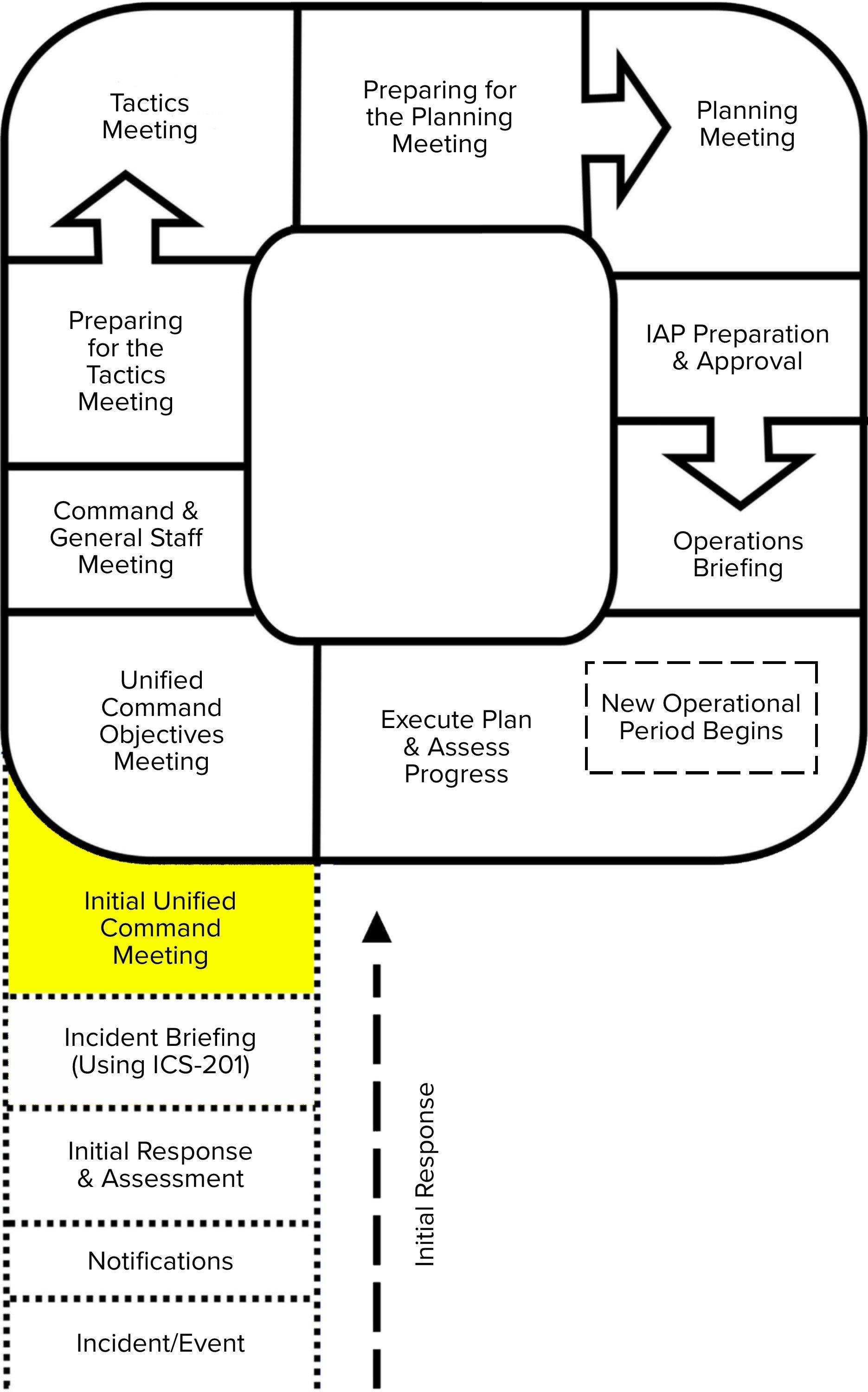INITIAL UNIFIED COMMAND MEETING
Overview: The Initial Unified Command Meeting provides Unified Command officials with an opportunity to discuss and concur on important issues and formulate key decisions prior to joint incident action planning. This meeting typically sets the tone for the overall response.
Schedule: The Initial Unified Command Meeting is scheduled as agency representatives integrate into the Unified Command response organization, typically upon conclusion of the Incident Briefing.
Attendees: Attendees for the Initial Unified Command Meeting potentially include the following:
Federal OSC.
State OSC.
Local OSC.
Responsible Party IC.
Planning Section Chief (PSC).
Documentation Unit Leader (DOCL).
Facilitator: Planning Section Chief (PSC).
Duration: Approximately 60 minutes.
Room Layout: The preferred room layout and seating arrangement for the Initial Unified Command Meeting is illustrated below:
RECOMMENDED AGENDA
- Incident Commander (RPIC).
- Federal OSC.
- State OSC.
- Local OSC.
- Planning Section Chief (PSC).
- Documentation Unit Leader (DOCL).
- Silence all electronic devices.
- Respect the meeting agenda.
- Be mindful of time.
- Presenters front and center.
- Limit interruptions and side conversations.
- Table discussions unrelated to the meeting.
- Name of the incident.
- Timeframe for the next operational period.
- Location of the Incident Command Post (ICP) and supporting facilities.
- Incident objectives and priorities.
- Staffing for both the current and next operational period.
- Meeting schedule for the current operational period.
- Key action items to address and by whom.
Incident Management
- Manage a coordinated inter-agency response effort that reflects composition of the Unified Command.
- Establish an Incident Management Team (IMT) capable of meeting the initial and long-term challenges required for incident mitigation.
- Inform the public, stakeholders,, and news media of response activities.
- Implement a coordinated response with law enforcement and other responding agencies.
- Evaluate planned actions to determine potential impacts on social, political, and economic entities.
- Establish a Volunteer Management Program.
- Adhere to appropriate financial accounting practices.
- Establish resource request and ordering procedures.
- Establish an incident documentation system.
- Establish an information transfer process to facilitate communications with stakeholders and organizations.
Oil Spill
- Initiate actions to stop/control the release and minimize the total spill volume.
- Implement measures to isolate, contain, and stabilize the incident.
- Examine the fate, effects, and trajectories of oil/hazardous substances.
- Identify sensitive areas.
- Conduct pre-impact shoreline debris removal.
- Contain, treat, and recover spilled materials.
- Conduct shoreline assessments and initiate cleanup actions.
Safety
- Maximize the protection of public health and welfare.
- Provide for the safety and security of responders.
- Conduct an operational risk assessment; ensure controls are in place to protect responders and the public.
Security
- Implement security awareness measures.
- Evaluate changes in incident effects and response conditions.
- Establish an Incident Security Plan, incorporating security badges.
- Implement scene integrity and evidence preservation measures.
- Investigate the cause of the incident.
- Establish and continue enforcement of safety and security zones.
- Implement airspace closure and monitoring.
Environmental
- Identify and protect environmentally sensitive areas, including wetlands.
- Identify threatened/endangered species; prepare to rescue and rehabilitate injured wildlife.
- Investigate the potential for alternative response technologies, e.g.,, in-situ burning, bioremediation, etc., in support of response efforts.
Firefighting
- Commence firefighting operations to contain, extinguish, and overhaul fire.
- Coordinate and support firefighting activities.
Crisis Management
- Maintain business survival.
- Minimize response costs.
- Maintain public image.
- Minimize local economic and tourism impacts.
- Minimize third-party claims.
- Minimize natural resource damage assessments.
- Re-establish commercial operation as soon as possible.
- Minimize prospects of criminal prosecution.
- Meet certain reasonable stakeholder expectations (public, agency, interest group, and political).
- Consider insurance limitations.
- Adverse weather.
- Challenging terrain/geography.
- Limited specialized resources.
- Staffing shortfalls.
- Crew rest requirements.
- Conflicting jurisdictional oversight.
- Delegation of authority.
- Inter-agency communications.
- Costs.
- News media coverage.
- Public confidence/perception.
- Political influences.
- Affected population.
- Adverse environmental/economic impacts.
- Community evacuations.
- Security.
- Evidence preservation.
- Exclusion zones.
- Oil composition.
- PPE requirements.
- Availability of waste receiving areas.
- Command & General Staff composition.
- Responder safety.
- Public health.
- Air monitoring.
- Incident stabilization.
- Source control.
- Environmental/property protection.
- Wildlife rescue/rehabilitation.
- Security.
- Transportation infrastructure.
- Maritime commerce restoration.
- Medical support.
- Stakeholder outreach.
- Media relations.
- Communications.
- Information management.
- Situational awareness.
- Incident investigation.
- Evidence collection.
- Injuries and/or fatalities.
- Personnel accountability.
- Waterway/port closures.
- Damage to infrastructure or company facilities.
- Equipment malfunctions.
- Total volume of the spill or rate of discharge.
- Resources status.
- Operational asset tracking.
- Environmental impacts.
- Resources at risk.
- Oiled wildlife.
- Cultural/historical impacts.
- News media interests/concerns.
- Social media trends.
- Political interests/concerns.
- Stakeholder concerns.
FEMA TRAINING VIDEO
The YouTube video above, produced by FEMA, depicts a simulated Initial Unified Command Meeting. The relevant content begins at the 1:00 mark.



